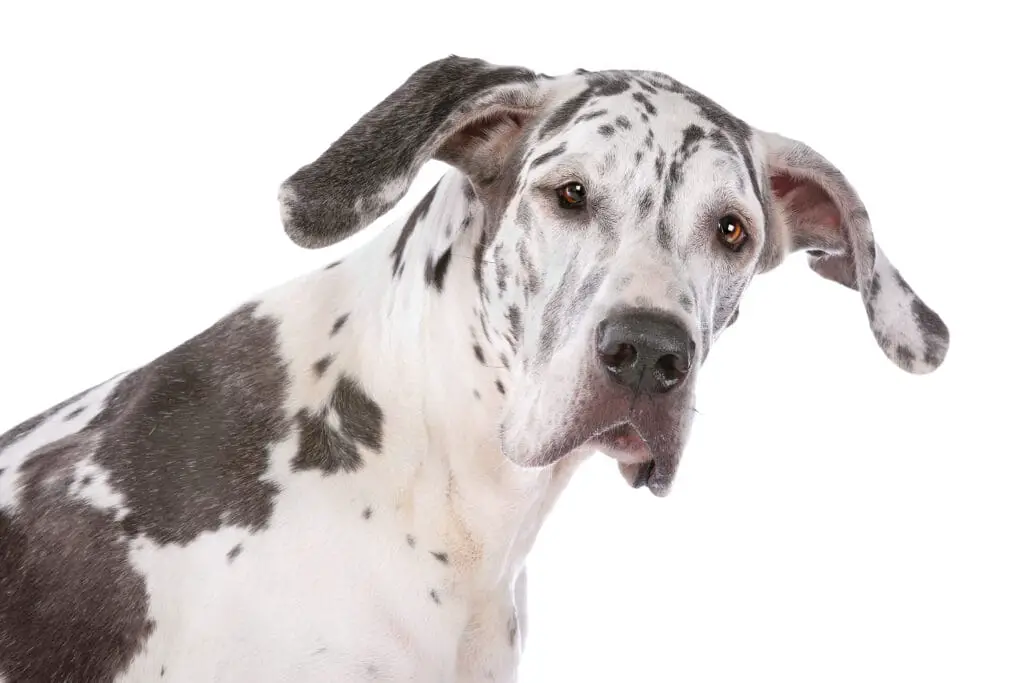Our website is supported by our users. We sometimes earn money when you click an affiliate link and make a purchase. This is at no extra cost to you and helps us to create quality content. Thank you for your support. For all that have shown us such wonderful support, we thank you from the bottom of our hearts!
The Great Dane one of the giant breeds known for its considerable size and regal appearance.
Originating from Germany, these gentle giants carry a history that dates back hundreds of years and have evolved from a fierce hunting dog to affectionate family companions.
Their stature is matched by a friendly demeanor, making them a popular choice for those who can accommodate their space requirements.

Caring for a Great Dane comes with unique considerations due to their sheer size.
Not only do they require ample room to stretch and exercise, but potential health issues like bloat call for a diligent, informed approach to their diet and care.
With the right environment and attention to their needs, Great Danes make loyal and loving additions to a family willing to take on the responsibility of a large breed.
Key Takeaways
- Great Danes are large, affectionate dogs with a history of versatility from hunting to companionship.
- They require sufficient space, exercise, and specific care to prevent health issues.
- These dogs are loyal companions who thrive in families that understand and meet their needs.
History of the Great Dane
The Great Dane breed, often referred to as the Apollo of Dogs, boasts an imposing yet elegant stature.
The history of this breed takes you back to Germany, no not Denmark, where it was developed from the German Mastiff, or Deutsche Dogge, into the iconic breed you recognize today.
Initially utilized for hunting wild boar, the Great Dane was admired for its strength and endurance.
In the 18th century, these dogs not only served as skilled hunting companions but also transitioned into esteemed working dogs.
Their presence in Europe was notable; in Denmark and Germany, they were often referred to as “Kammerhunde,” reflecting their status among the nobility.
By the late 19th century, the American Kennel Club (AKC) recognized the breed, further cementing its global prominence.
The Great Dane Club of America is one of the oldest breed clubs in the United States, a testament to the Great Dane’s longstanding appeal.
| Country | Role | Registry |
|---|---|---|
| Germany | Country of Origin | Deutsche Dogge |
| Denmark | Historical Ties | Grand Danois |
| America | Breed Recognition | American Kennel Club |
While Great Danes are less often seen on the hunt today, your appreciation for their history enriches the understanding of this regal breed.
Their transition from ferocious boar hounds to gentle companions showcases the breed’s adaptability and enduring charm.
Physical Characteristics of the Great Dane

The Great Dane, often referred to as a “gentle giant,” stands out with its impressive size and elegant stature.
You’ll find these dogs possess a powerful, lean build that exudes strength without any loss of their well-known gracefulness.
Physical traits include:
Height Male
Males typically stand between 30 to 34 inches at the shoulder.
Height Female
Females are generally shorter, with a height ranging from 28 to 32 inches.
Weight Male
Male Great Danes can weigh from 120 to 200 pounds.
Weight Female
Female Great Danes are usually lighter, with weights falling between 99 to 130 pounds.
Eye Colors
Their expressive eyes come in various shades, including dark brown, blue, or hazel.
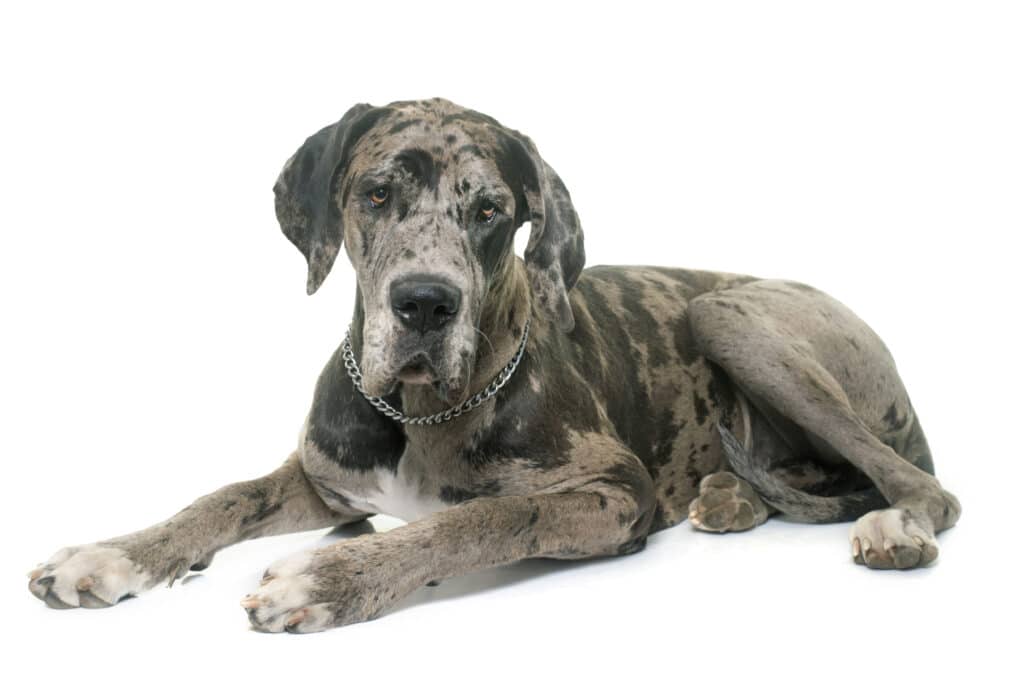
Coat Colors
The coat may exhibit several colors such as fawn, black, blue, brindle, harlequin, or mantle.
Coat Types
They have a short, smooth coat that lends to their sleek appearance.
Life Expectancy
Typically, large breeds have a shorter life expectancy than smaller dogs, and these dogs have a life span ranging from 6 to 8 years.
Overview of the Physical Characteristics
Your Great Dane’s physical makeup is characterized by a square frame, a muscular and smooth body, and a refined, noble appearance.
Their considerable size does not undermine their gentle temperament, as they carry their height and weight with quiet confidence.
Temperament & Training
Known as the “gentle giant,” the Great Dane exhibits a friendly and affectionate temperament, embodying both strength and gentleness.
With origins in Germany, this breed is often admired for its regal appearance and companionable nature. Here’s what you need to know about their temperament and how to train them effectively.
They will benefit from puppy training classes when they are younger dogs so that they can learn good manners before they get too large to handle easily.
Temperament:
- Gentleness: Despite being large dogs, Great Danes are typically gentle and easygoing.
- Friendliness: These dogs are known for their friendliness and affection towards their families.
- Social Nature: Being social animals, Great Danes thrive on companionship and shouldn’t be left alone for long periods.
- Playfulness: They are playful and require regular interaction with their owners or other dogs.
Training:
- Consistency is Key: Start training at a young age, using consistent commands and positive reinforcement.
- Exercise: Moderate exercise is essential to keep your Great Dane healthy; however, avoid over-exertion, especially in puppies.
- Socialization: Socialize them early with people and other dogs to ensure they are well-rounded.
- Mental Stimulation: Implement games and toys to keep them mentally challenged.
Great Danes learn quickly and are for the most part good with basic commands.
Their obedience training should emphasize their natural friendliness while curbing any overprotective behavior.
Remember, these dogs may not know their own strength, so due to their massive size, it’s essential to reinforce gentle play, especially around children.
By investing time and love into training your dog, your gentle giant will be as regal and well-mannered as the famous Scooby-Doo.
This breed’s combination of courage, playfulness, and affection makes for a wonderful, loving pet.
Health Issues
Great Danes are majestic dogs with a commanding presence, but they also have specific health conditions that you should be aware of.
Your awareness and understanding can play a crucial role in managing your Great Dane health.
Bloat a.k.a. Gastric Dilatation-Volvulus or Gastric Torsion
Bloat, also known as Gastric Dilatation Volvulus (GDV) or Gastric Torsion, is a life-threatening condition in Great Danes, due to their large size and deep chest.
This condition occurs when the stomach fills with gas, causing it to twist on its axis, which can lead to a blockage of blood flow.
Great Danes are particularly predisposed to GDV due to their anatomy.
Symptoms include restlessness, unproductive attempts to vomit, a distended abdomen, and signs of discomfort.
Immediate veterinary attention is vital for diagnosis and treatment, typically involving decompression of the stomach and stabilization of the dog.
Preventive measures, such as feeding multiple small meals and avoiding strenuous exercise after eating, are essential for minimizing the risk of GDV in Great Danes.
Regular veterinary check-ups and awareness of the breed’s susceptibility to this condition contribute to early detection and effective intervention.
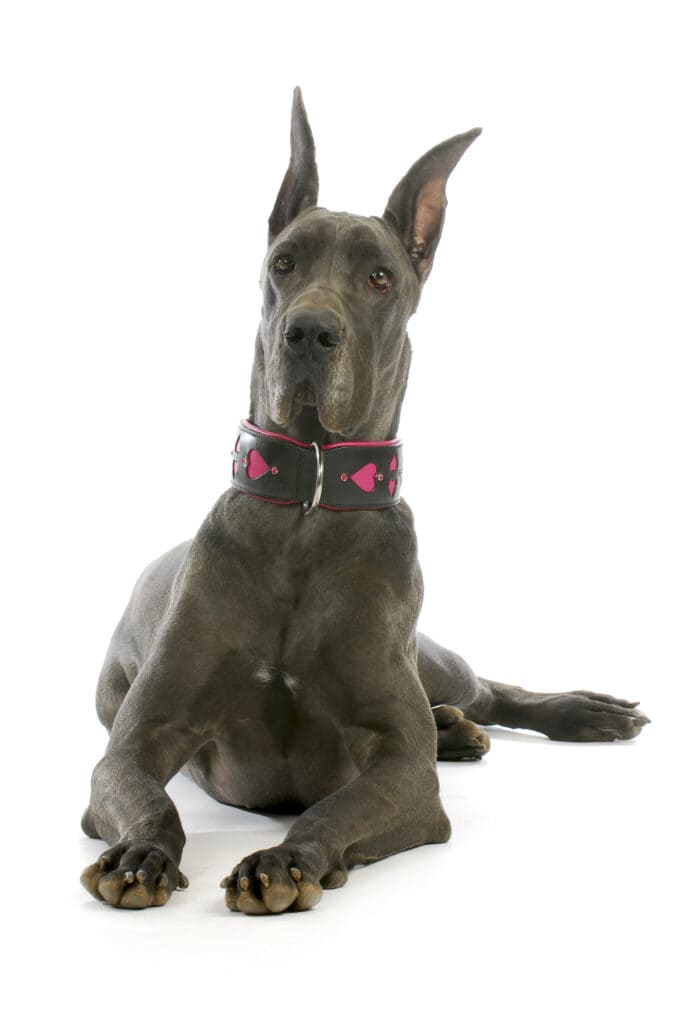
Cardiomyopathy:
Cardiomyopathy is one of the prevalent health problems in Great Danes, particularly Dilated Cardiomyopathy (DCM).
This heart disease is characterized by the enlargement and weakening of the heart chambers, ultimately leading to reduced cardiac function.
Great Danes are genetically predisposed to DCM, which can result in symptoms such as lethargy, exercise intolerance, coughing, and, in advanced stages, congestive heart failure.
Regular veterinary check-ups, including heart screenings, are crucial for early detection and management of cardiomyopathy in Great Danes.
While there is no cure for DCM, treatment strategies focus on slowing disease progression and alleviating symptoms through medications and lifestyle adjustments.
Responsible breeding practices and owner awareness play vital roles in addressing and reducing the prevalence of cardiomyopathy within the Great Dane population.
Hip Dysplasia:
Hip dysplasia is a notable orthopedic concern in large-breed dogs including Great Danes.
This hereditary condition involves abnormal development of the hip joint, leading to instability, pain, and potential mobility issues.
Great Danes are prone to hip dysplasia due to their size and rapid growth during puppyhood. Symptoms may include lameness, difficulty rising, and reluctance to engage in physical activities.
While hip dysplasia is incurable, management strategies aim to improve the dog’s quality of life.
Weight control, moderate exercise, and joint supplements are often recommended.
Responsible breeding practices, including screening breeding dogs for hip dysplasia, play a crucial role in reducing the prevalence of this condition in the Great Dane population.
Regular veterinary check-ups and early detection contribute to effective management and improved well-being for Great Danes with hip dysplasia.
Cancer:
Cancer is a significant health concern in Great Danes, and they are predisposed to certain types of cancer, including osteosarcoma (bone cancer), lymphoma (lymph cancer), and hemangiosarcoma (blood vessel lining cancer).
Due to their large size, these dogs may be more susceptible to musculoskeletal issues that can increase the risk of certain cancers.
Clinical signs may include lumps or swelling, changes in weight, lethargy, and altered behavior.
Early detection is crucial, and Great Dane owners should be vigilant for any abnormal signs, seeking prompt veterinary attention for an accurate diagnosis.
Treatment options for cancer in Great Danes may involve surgery, chemotherapy, or radiation therapy, depending on the type and stage of cancer.
Regular veterinary check-ups and awareness of the breed’s predisposition to cancer contribute to early detection and timely intervention, improving the overall prognosis for affected Great Danes.
Wobblers Syndrome
Wobbler Syndrome, formally known as cervical spondylomyelopathy, is a neurological condition that can affect Great Danes, among other large and giant breeds.
This disorder involves compression of the spinal cord in the neck region, leading to symptoms such as an unsteady or wobbly gait, difficulty standing, and weakness in the hind limbs.
Great Danes, with their size and unique conformation, may be more susceptible to Wobblers Syndrome.
The condition is often progressive, and while treatment options may include medications, physical therapy, and in some cases, surgery, the overall prognosis can vary.
Early detection through vigilant observation and consultation with a veterinarian is crucial for managing Wobblers Syndrome and optimizing the affected Great Dane’s quality of life.
Grooming
Proper grooming is essential for maintaining your Great Dane’s overall health and appearance.
Your gentle giant has a short coat that doesn’t shed excessively but requires regular care.
Brushing
Frequency: Give your Great Dane weekly brushing to keep their coat shiny and to minimize shedding.
Use a bristle brush or a rubber grooming mitt to remove loose hair and distribute skin oils.
This EquiGroomer is used by dog groomers with great results.
Bathing
Schedule: Bathe your Great Dane every 6 to 8 weeks or as needed.
Use a mild dog shampoo to avoid skin irritation. Bathing too often strips natural oils, so ensure it’s not overdone.
This ELEGX massager is great for shampooing and gives your dog a nice massage.
Cutting Fur/Hair
Great Danes have short hair that doesn’t typically need cutting.
However, you should check for any uneven patches or abrasions that may require attention during your regular grooming routine.
Clipping or Grinding Nails
Tools: Choose a quality nail clipper or a grinder for a smoother finish.
Frequency: Clip or grind your dog’s nails at least every month.
Long nails can affect their gait and lead to joint problems.
If you take your dog to a groomer, they will handle clipping or grinding your dog’s nails.
Often, you can bring your dog into the groomer and they will do it even if you don’t do a full grooming.
Also, your veterinarian will cut your dog’s nails, be we have found that it is more expensive that way.
If you are nervous or need more information, check out our article on How to Grind Your Dog’s Nails or How to Clip Your Dog’s Nails Safely.
It will be tricky at first but after you get the hang of it, it’s fairly easy.
Use dedicated dog nail clippers or a grinder designed for small dogs.
The only concern is cutting your dog’s nails too short.
If you cut the quick, dip their nails in Styptic Powder to stop the bleeding.
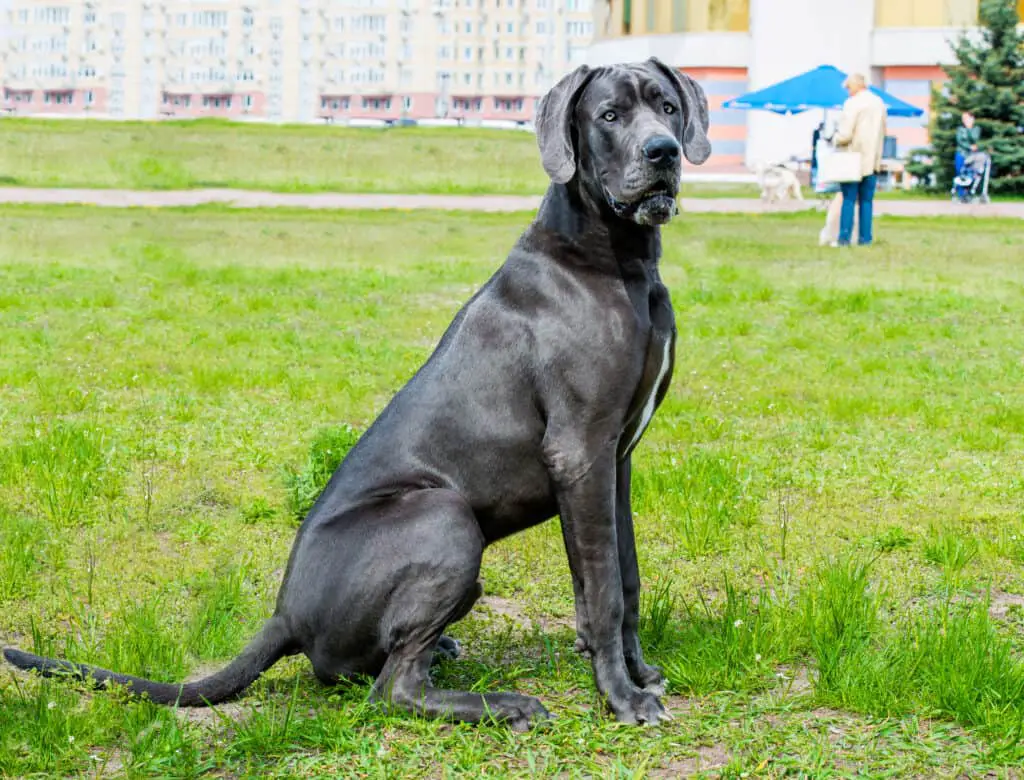
Dental Care
Daily brushing is recommended to prevent dental diseases.
Use a toothbrush designed for dogs and enzymatic toothpaste.
Dental chews can supplement brushing but shouldn’t replace it.
Cleaning Ears
Inspect and clean your Great Dane’s ears weekly to prevent infections.
Use a vet-approved ear cleaner and cotton balls to gently remove dirt.
We like these Pet MD – Dog Ear Cleaner Wipes – Otic Cleanser for Dogs as they are super easy to use and convenient.
By adhering to this routine, you’ll keep your Great Dane’s appearance neat and contribute to their overall well-being.
Owning
Owning a Great Dane is a significant commitment involving careful consideration of the initial cost, ongoing expenses, and the process of choosing a loyal companion.
Your responsibilities will include meeting their specific care requirements and accommodating their size and energy levels.
Cost of Purchase
The initial cost of purchasing a Great Dane puppy typically ranges from $600 to $3,000, depending largely on the breeder’s reputation and the pedigree of the puppy.
Some breeders in Pennsylvania, known for their quality breeding practices, may charge on the higher end of this spectrum.
Remember, the cost can also be influenced by the Great Dane’s potential as a watchdog or show dog within its group.
Maintenance Costs
| Expense Category | Estimated Cost |
|---|---|
| Food & Diet | $60 – $120/month |
| Medical Costs | $200 – $500/year |
| Grooming | $0 – $500/year |
| Training | $50 – $200/session |
Great Danes are a giant breed requiring a substantial diet to meet their nutritional needs.
Monthly feeding costs can be considerable given their size.
They are generally affectionate dogs that also need regular veterinary care to maintain health throughout their lifespan of around 7-10 years.
Grooming costs are typically lower than other breeds, but you may invest in special training to ensure your Great Dane remains well-behaved both on and off the leash.
Adopting
Adopting this breed can be a compassionate alternative to purchasing from a breeder, often with a lower cost of purchase.
When adopting, you not only give a home to a dog that may need one, but you could also spend less on upfront costs.
Adoption fees usually cover initial medical costs, which include vaccinations, spaying or neutering, and sometimes even microchipping.
Finding Reputable Breeders
If you decide to purchase Great Dane puppies from a breeder, ensure they are a reputable breeder and have a transparent process to help you find the right puppy.
A trustworthy breeder should provide health clearances for the parents and allow you to see the conditions in which the puppies are raised.
Be prepared for a high energy level pup that will grow into a giant breed, requiring an appropriate fence in your yard and ample space at home.
A responsible breeder will also help you understand the Great Dane’s role as a companion and their active nature.
Frequently Asked Questions

Great Danes are remarkable dogs with unique needs and characteristics.
This section provides concise answers about their size, coat, behavior, care, guarding abilities, and the reason behind their poignant nickname.
What is the general size and weight range for an adult Great Dane?
An adult male typically stands at 32 inches and weighs around 175 pounds, whereas a female usually reaches up to 30 inches in height and weighs close to 140 pounds.
What are the common coat colors and patterns found in Great Danes?
They exhibit a variety of coat colors including fawn, brindle, blue, black, harlequin, and mantle.
Their patterns can be solid, or marked with spots and patches, especially in the case of harlequin-coated Danes.
How do Great Danes typically behave as family pets and with children?
They are known for their gentle and affectionate nature, making them excellent family pets.
They are usually patient with children, demonstrating a blend of playfulness and protective instinct.
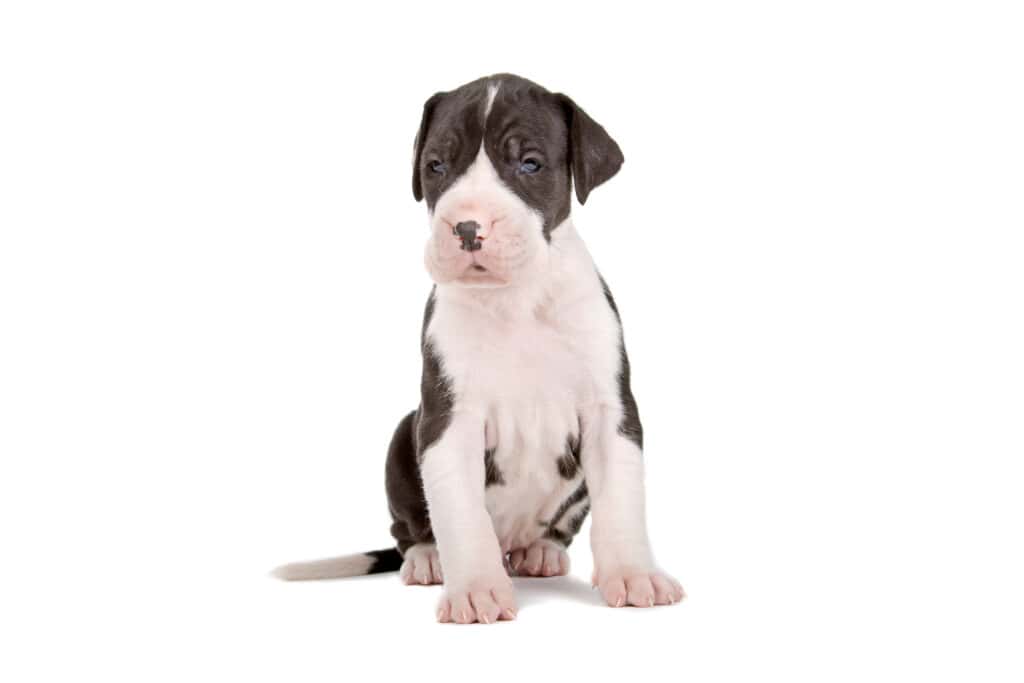
What level of care and maintenance do Great Danes require?
Great Danes need regular exercise to maintain their health but should be monitored to prevent joint problems due to their large size and weight.
They also require a balanced diet, grooming, and frequent vet check-ups to manage their well-being.
What are the characteristics that qualify Great Danes as guard dogs?
Despite their friendly demeanor, they are alert and can be imposing due to their size, which makes them effective as guard dogs.
Their loyalty and instinct to protect their family are inherent qualities that contribute to this role.
Why have Great Danes earned the nickname ‘the heartbreak breed’?
They are referred to as ‘the heartbreak breed’ due to their relatively short lifespan combined with a propensity for health issues like heart conditions, bloat, and joint disorders, which can lead to early and often unexpected loss for their owners.
Bottom Line on the Great Dane

When considering a Great Dane as your companion, you’re looking at a breed with a noble and gentle presence.
Standing between 28 to 34 inches at the shoulder and weighing between 110 to 175 pounds, they are one of the largest dog breeds, known for a regal appearance complemented by a smooth coat that comes in various colors and patterns.
Key Traits:
- Size: Males typically 30-32 inches, Females 28-30 inches tall.
- Weight: Males 140-175 lbs, Females 110-140 lbs.
- Lifespan: 7 to 10 years.
- Personality: Friendly, dependable, and courageous.
Despite their size, Great Danes are known for their affable personalities, typically forming strong bonds with their families.
They tend to be friendly towards children and other dogs when properly socialized.
Your Great Dane will require a substantial amount of space to move freely and comfortably, so consider your living environment and availability for exercise.
In terms of care, it’s crucial to note their dietary requirements, health considerations, such as a propensity for certain genetic conditions, and grooming needs, which consist primarily of regular coat maintenance and nail care.
As a Great Dane owner, you’ll play a pivotal role in their training and socialization to foster their natural elegance and kind temperament.
Ensure that you’re ready for the commitment required to give these gentle giants the love and care they deserve.
Please read our Legal Disclaimer

